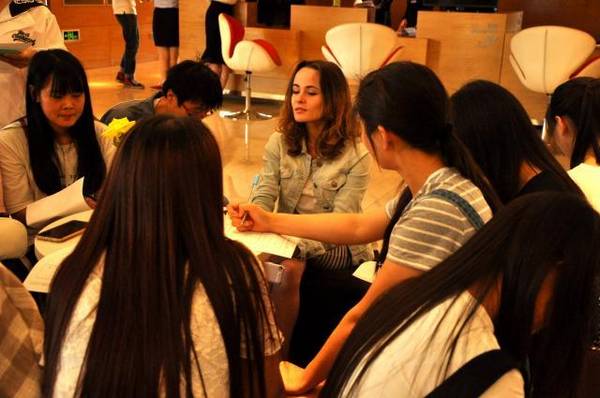亲子英语 Field Trip材料——颐和园(The Summer Palace)
2023-01-19 06:16:34 | 人围观 | 评论:
- 2023-01-19 06:16:34亲子英语 Field Trip材料——颐和园(The Summer Palace)
The Summer Palace (Yiheyuan), in northwest Beijing, is said to be the best-preserved imperial( /mpril/) garden in the world, and the largest of its kind still in existence in China. It is only a short drive of 15 km (10 miles) from central Beijing, but it seems like another world.
颐和园坐落于北京西郊,是世界上保存最为完好的皇家御苑,也是我国现存最大的皇家园林。颐和园距北京市中心仅15公里(10英里),但那里确“别有洞天”。
Most people find they need to spend at least half a day there, as there’s so much to see and enjoy.
多数游客发现游览颐和园至少需要半天时间,因为那里有太多东西值得观赏和品味。
Close to the Summer Palace, 3 kilometers (2 miles) southwest of it, there is another imperial garden called the Old Summer Palace. They are two different gardens.
与颐和园毗邻,位于其西南3公里处(2英里)有另外一家皇家园林——圆明园。这两个园林截然不同。
Summer Palace Facts 颐和园点滴
Chinese: 颐和园 “Nourishing /nr/ Peace Garden”
汉语:颐和园,意为“颐养太和”
Area: 2.9 square kilometers (1.1 sq mi)
面积: 2.9平方公里(1.1平方英里)
Age: 257 years (in 2021, completed 1764)
时间:距2021年,已有257年历史(建成于1764年)
Popular activities: boating on Kunming Lake,
walking the Long Corridor,
watching a traditional Chinese performance in the ancient theater
热门活动:乘船游览昆明湖;
漫步长廊;
在古剧院观看中国传统戏剧表演。
Suited to: anyone
适合人群:所有
Time needed: half a day
所需时间:半天
Why Is the Summer Palace Famous? 颐和园因何闻名?
The Summer Palace was listed as World Heritage in 1998. UNESCO(United Nations Educational, Scientific, and Cultural Organization) reported that the Summer Palace is "a masterpiece of Chinese landscape garden design”.
颐和园于1998年被列为世界文化遗产。联合国教科文组织称颐和园是“中国园林设计的杰作”。
Comment from the World Heritage Committee 世界遗产委员会评价
The Summer Palace in Beijing was initially built in 1750, severely damaged in the smoke and fire of war in 1860, and renovated on the original site in 1886. Artificial landscapes such as pavilions, halls, corridors, temples and small bridges all live side by side in harmony with the nearby hills and the vast lake to form a harmonious ensemble of outstanding aesthetic value. It undoubtedly deserves its reputation as a masterpiece of Chinese landscape garden design.
北京颐和园始建于公元1750年,1860年在战火中严重损毁,1886年在原址上重新进行了修缮。其亭台、长廊、殿堂、庙宇和小桥等人工景观与自然山峦和开阔的湖面相互和谐、艺术地融为一体,堪称中国风景园林设计中的杰作。
The ‘Imperial Garden Museum’ 皇家园林博物馆
The Summer Palace is known as the ‘Imperial Garden Museum’ in China as its purpose now is the preservation of national heritage material. It harmonizes plants and paths, water and land, architecture and horticulture /hrtkltr/, epitomizing /ptmaz/ the philosophy and practice of Chinese garden design.
由于颐和园当前的意义是提供保护国家文化遗产的资料,因此其被誉为“皇家园林博物馆”。颐和园中的植被和小径,水系及陆地,建筑及园艺融为一体, 是中国园林设计理念与实践的缩影。
The Summer Palace played a key role in the development of this Oriental cultural form, and perhaps represents its pinnacle /pnkl/.
颐和园在这种东方文化形式的发展过程中扮演了关键的角色,或许是其巅峰之作。
A Summer Retreat for the Royal Family 皇家避暑胜地
The Summer Palace was used as a summer retreat by the Chinese royal family. During the hot Beijing summers, the imperial family preferred the beautiful gardens and airy pavilions of the Summer Palace to the walled-in Forbidden City. Dowager /dadr/ Empress Cixi took up permanent residence there for a time, giving rise to some wonderful tales of extravagance /kstrvɡns/ and excess.
颐和园是皇家的避暑胜地。北京酷暑之时,皇家成员更喜爱颐和园风景优美的花园以及空气清新的亭台,而非高墙环绕的紫禁城。慈禧太后曾于此长居,因此留下了一些关于她奢靡生活的精彩故事。
Summer Palace History 颐和园的历史
Construction — Began in 1750
建造——始于1750年
Emperor Qianlong ordered the construction of the Summer Palace to celebrate his mother's sixtieth birthday. The Summer Palace was built in 1750 and completed in 1764. At that time, the Summer Palace was not called the Summer Palace, or even Yiheyuan, but Qingyiyuan (‘Clear Ripples Garden’).
乾隆皇帝下令修建颐和园,庆祝其母亲六十大寿。颐和园始建于1750年,1764年完工。当时,颐和园不叫颐和园,叫清漪园(“河水清且涟漪”之意)。
Burned — 1860
烧毁——1860年
In the late Qing Dynasty, due to the weakening of national power, the garden was gradually abandoned. In 1860, it was destroyed by British and French allied forces.
在清朝后期,由于国力衰弱,颐和园被逐渐荒废。1860年,清漪园被英法联军烧毁。
Rebuilt — 1884–1895
重建——1884年至1895年
The Empress Dowager Cixi rebuilt the garden as her summer resort and changed its name to the Summer Palace (Yiheyuan), its present name.
慈禧太后要求重建清漪园,作为其避暑之地,并更名为颐和园,沿用至今。
In order to rebuild the Summer Palace, military expenditure was diverted/davrt/, which contributed to the Qing government's defeat in the First Sino-Japanese War in 1895.

为了重建颐和园,军费被挪用,直接导致清政府在1895年的中日甲午战争中的战败。
In 1900, it was destroyed by the Allied Forces of the Eight Powers during the defeat of the Boxer Rebellion, but it was rebuilt again in 1902.
1900年,在剿灭义和团时,八国联军摧毁颐和园,但其于1902年再次重建。
Opened to the Public — 1914
向公众开放——1914年
In 1912, the Qing Dynasty ended, and the Summer Palace became the private property of the former imperial family of the Qing Empire. Two years later, the Summer Palace was opened to the public.
1912年,清朝政府灭亡。颐和园变为清朝前皇室的私有财产。2年后,颐和园向公众开放。
In 1924, the Beijing municipal government took charge of administrating the Summer Palace and turned it into a public park.
1924年,北京市政府负责管理颐和园,并将其改为公园。
The Summer Palace’s Layout 颐和园布局
The Summer Palace’s largest features are Longevity /lndevti/ Hill and Kunming Lake.
颐和园最大的特色是万寿山和昆明湖。
Longevity Hill is in the north of the

Summer Palace, accounting for about a quarter of the whole garden.
万寿山位于颐和园北部,约占整个园林的四分之一。
Most palaces and gardens were built along the north–south axis of Longevity Hill.
大部分宫殿沿长寿山南北轴建造。
These palaces fall into several sections, each with its own distinct character, some meant for administration, some living, and others relaxation.
这些宫殿可分为几个部分,每个部分都有其独特之处,有些用于行政,有些用于居住,还有一些用于休闲。
People usually divide Longevity Hill into the ‘front hill’ area and ‘back hill’ area.
人们通常把万寿山分为“山前”和“山后”两部分。
Kunming Lake takes up three quarters of the whole garden and is dotted with several small islands. These small islands also host some halls and pavilions.
昆明湖占据整个园林的四分之三,湖面山点缀着零星的小岛。这些小岛上有一些宫殿和亭台。
Summer Palace Attractions 颐和园的景点
Palaces, halls, pavilions, the long corridor, and the marble boat are the main things to see in the Summer

Palace gardens.
宫殿、亭台、长廊和石舫构成了颐和园的主要景观。
1. Tower of Buddhist Incense(/nsens; nsens/ n. 香;v.焚香) 佛香阁
It is the main building of the Summer Palace complex, built halfway up the front of Longevity Hill. Empress Dowager Cixi went there every month to worship Buddha.
这是颐和园建筑群的主要建筑,建在万寿山山前的半山腰。慈禧太后每个月都要前往礼佛。
2. Hall of Dispelling Clouds 排云殿
This was the Summer Palace’s main place for Empress Dowager Cixi to receive guests, host grand ceremonies, and celebrate her birthday. Like the Tower of Buddhist Incense, it is located on the central axis of the ‘front hill’ area.
排云殿是颐和园中慈禧太后接待客人,举办盛大仪式和庆祝生日的主要场所。于佛香阁一样,排云殿位于山前区域的中轴线上。
3. Hall of Benevolence /bnevlns/ and Longevity 仁寿殿
This was the main place for administering government affairs, receive greetings, and receive foreign envoys.
这里是管理政务、迎宾和接待外国使节的主要场所。
4. The Long Corridor 长廊
The paths beside the lake lead you under shady trees, or along the roofed colonnade /kɑlned/ known as the Long Corridor, with its magnificently painted ceilings. Bridges, boats, willows, lotus flowers, and other attractive landscaping make this a pleasant place to soak up the atmosphere and lovely views.
沿着湖边小径,你可以在树荫下漫步,或者沿着柱廊漫步,这就是著名的“长廊”。廊顶上有华丽的才会。桥、船、柳树、荷花和其他引人注目的景观让这里成为弥漫着愉悦气息、汇聚可爱景观的地方。
Facing Kunming Lake, it's 728 meters (2,388 feet) long. In 1992, it was recognized as the longest corridor in the world and listed in "The Book of Guinness World Records".
长廊面向昆明湖,长728米(2388英尺)。1992年,它被认定为世界上最长的走廊,并被列入《吉尼斯世界纪录大全》。
5. The Garden of Virtue and Harmony 德和园
It was built as a theater for the Empress Dowager Cixi. The three-story theater stage is the biggest and best-preserved wooden stage in China. Famous Beijing opera actors of the Qing Dynasty would come to perform for the Empress Dowager and the stage was regarded as the "Cradle of Beijing Opera".
这是专门为慈禧太后修建的戏院。三层的戏台是中国最大、保存最完好的木制舞台。清代京剧名家来此为皇太后表演,该戏台被称为“京剧的摇篮”。
6. Sea of Wisdom 智慧海
It is located on the peak of Longevity Hill. The outer layer of the building is decorated with exquisite yellow and green glazed /ɡlezd/ tiles.
智慧海位于万寿山山顶。建筑的外层被黄绿色琉璃瓦片装饰。
7. Hall of Jade Ripples 玉兰堂
This hall was the living quarters of Emperor Guangxu (1871–1908). When Empress Dowager Cixi gained real power, Guangxu was confined there.
玉兰堂是光绪皇帝的寝宫。慈禧太后掌权后,光绪便被囚禁与此。
8. Hall of Joy and Longevity 乐寿堂
This hall was the living quarters of Empress Dowager Cixi. Facing Kunming Lake, and leaning against Longevity Hill, reaching out to the Hall of Benevolence and Longevity in the east and the Long Corridor in the west, it is the best place for living and relaxation in the Summer Palace complex.
乐寿堂是慈禧太后的寝殿。它面临昆明湖,背倚万寿山,东达仁寿殿,西接长廊。是院内位置最好的居住和游乐的地方。
9. Suzhou Street 苏州街
Suzhou Market Street recreates a selection of traditional riverside shops (as would have been found in Suzhou), many of which can only be reached by boat. The story goes that former Emperors, or their concubines, used to enjoy 'pretend-shopping', as normally everything was bought for them.
苏州市场街重现了一系列传统的河边商铺(一般出现在苏州),其中很多商铺只能乘船前往。传说,皇上和他的嫔妃们喜欢“假装购物”,因为通常所有的商品都是为他们准备的。
10. The Marble Boat石舫
The Marble Boat, at the northern edge of the lake, is a decorative building that imitates a real boat. Erected in 1755, it is the only Western-style structure in the park, inlaid with colorful glass windows and wheels, and paved with colored bricks.
位于湖北岸的石舫是一座模仿真实船只建造的装饰性建筑。石舫建于1755年,是颐和园内唯一的西式建筑,其窗户和轮子镶嵌着彩色玻璃,船体用彩色砖铺设。
11. Kunming Lake and 17-Hole Bridge 昆明湖和十七孔桥
Kunming Lake, in the center of the park, takes up about 75% of the park. Boating on Kunming Lake is highly recommended. It takes about 10 minutes and gives a tranquil and relaxing break away from the crowds of tourists confined to the pathways. The boating fee is not included in the entrance fee.
位于颐和园中心的昆明湖占据了公园约75%的面积。泛舟于昆明湖是被推荐最多的项目。乘船游湖约需要10分钟,可以让游客从拥挤的人群中出来,得到片刻的宁静和放松。乘船费用不包含在门票中。
The famous 17-hole bridge spans between Nanhu (‘South Lake’) Island and the east bank. The bridge is 150 meters (490 ft) long, and is curved like a long rainbow frame above the blue water.
著名的十七孔桥横跨南湖岛和东岸。桥长150米(490英尺)。弯弯的桥仿佛一道彩虹跨在蓝色的湖水上。
相关内容推荐:
- 推荐阅读
- 最热文章
全站搜索